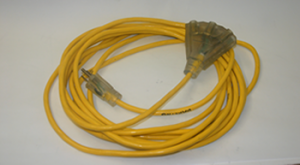Print a Sign-In Sheet | Spanish Version
It is important to inspect your electrical equipment daily and follow safety procedures. This applies to the use of flexible extension cords as well. Whether it is at home, work, office, or construction site, most of us use extension cords on a daily basis. Thus, it is easy to overlook their potential hazards. Remember electricity can be dangerous. By following the safety steps listed below when working with extension cords, electrical shocks and injuries may be prevented.
Extension Cord Don’ts
- Do not plug in flexible extension cords with wet hands.
- Do not remove cords by pulling on the cord, pull on the plug.
- Do not daisy chain power strips.
- Do not use extension cords as a substitute for fixed wiring.
- Do not run cords through windows, doorways or through holes in walls, ceilings or floors.
- Do not use the cord to raise or lower equipment.
- Do not fasten cords with staples.
- Do not modify plugs or cords in any way.
Extension Cord Dos
- Do visually inspect cords and plugs for damage, such as missing ground prongs or cuts to the rubber installation, prior to using them.
- Do remove all damaged cords from service.
- Do plug cords into properly grounded outlets.
- Do use extension cords that are 3-wire type.
- Do use cords that are rated for hard or extra hard use in construction areas.
- Do use the proper gauge of extension cord by choosing one that matches the amount of electrical current it will carry.
American Wire Gauge (AWG)
| Wire size | Handles up to |
| #10 AWG | 30 amps |
| #12 AWG | 20 amps |
| #14 AWG | 15 amps |
| #16 AWG | 13 amps |
Remember: The larger the gauge number, the smaller the wire.
KEMI does not assume liability for the content of information contained herein. Safety and health remain your responsibility. This information is to be used for informational purposes only and not intended to be exhaustive or a substitute for proper training, supervision or manufacturers’ instructions/recommendations. KEMI, by publication of this information, does not assume liability for damage or injury arising from reliance upon it. Compliance with this information is not a guarantee or warranty that you will be in conformity with any laws or regulations nor does it ensure the absolute safety of any person, place or object, including, but not limited to, you, your occupation, employees, customers or place of business.

